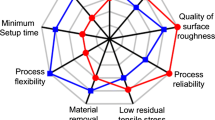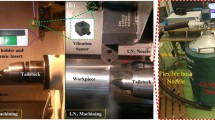Abstract
The machining of hardened materials with hardness over 45 HRC has been an alternative to grinding since the 1970s, with the commercial availability of cubic boron nitride (cBN) and ceramic tools. However, the low toughness of these types of tool materials makes them very sensitive to damages caused by vibrations, which are critical for operations like internal turning, where the tool resembles a cantilever beam and therefore is susceptible to large deflections. This work aims to contribute to the study of tool performance in internal turning of long holes in hardened AISI 4340 steel in finishing conditions. Different machining conditions, two different tool holders (steel and carbide), and several tool overhangs were tested. The surface finish, acceleration (vibration) signals, and tool wear of cBN inserts were evaluated. The results show that vibration and the material of the tool holder may play a secondary role in the surface finish for stable turning, but the use of carbide tool holders makes the process stable for longer tool overhangs. Moreover, when the cutting becomes unstable, surface roughness is increased severely.
Similar content being viewed by others
References
Klocke F, Brinksmeier E, Weinert K (2005) Capability profile of hard cutting and grinding processes. CIRP Ann Manuf Technol 54(2):22–45. doi:10.1016/S0007-8506(07)60018-3
Bartarya G, Choudhury SK (2012) State of the art in hard turning. Int J Mach Tools Manuf 53:1–14. doi:10.1016/j.ijmachtools.2011.08.019
Huddle D (2001) New hard turning tools and techniques offer a cost-effective alternative to grinding. Tooling Prod Mag 80:96–103
Dogra M, Sharma VS, Sachdeva A, Suri NM, Dureja JS (2010) Tool wear, chip formation and workpiece surface issues in CBN hard turning: a review. Int J Precis Eng Manuf 11(2):341–358. doi:10.1007/s12541-010-0040-1
Chinchanikar S, Choudhury SK (2015) Machining of hardened steel—experimental investigations, performance modeling and cooling techniques: a review. Int J Mach Tools Manuf 89:95–109. doi:10.1016/j.ijmachtools.2014.11.002
Oliveira AJ, Diniz AE, Ursolino DJ (2009) Hard turning in continuous and interrupted cut with PCBN and whisker-reinforced cutting tools. J Mater Process Technol 209:5262–5270. doi:10.1016/j.jmatprotec.2009.03.012
Godoy VAA, Diniz AE (2011) Turning of interrupted and continuous hardened steel surfaces using ceramic and CBN cutting tools. J Mater Process Technol 211:1014–1025. doi:10.1016/j.jmatprotec.2011.01.002
Tönshoff HK, Arendt C, Ben Amor R (2000) Cutting of hardened steel. CIRP Ann 49(2):547–566. doi:10.1016/S0007-8506(07)63455-6
Diniz AE, Gomes DM, Braghini A Jr (2005) Turning of hardened steel with interrupted and semi-interrupted cutting. J Mater Process Technol 159:240–248. doi:10.1016/j.jmatprotec.2004.05.011
Altintas Y (2000) Static and dynamic deformations in machining. In: Altintas Y (ed) Manufacturing automation: metal cutting mechanics, machine tool vibrations, and CNC design. Cambridge University Press, New York, pp 65–121
Rivin EI, Kang H (1992) Enhancement of dynamic stability of cantilever tooling structures. Int J Mach Tools Manuf 32(4):539–561. doi:10.1016/0890-6955(92)90044-H
Akesson H, Smirnova T, Hahansson L (2009) Analysis of dynamic properties of boring bars concerning different clamping conditions. Mech Syst Signal Process 23:2629–22647. doi:10.1016/j.ymssp.2009.05.012
Andrén L, Hakansson L, Brandt A, Claesson I (2004) Identification of dynamic properties of boring bar vibrations in a continuous boring operation. Mech Syst Signal Process 18:869–901. doi:10.1016/S0888-3270(03)00093-1
Atabey F, Lazoglu I, Altintas Y (2003) Mechanics of boring processes—part I. Int J Mach Tools Manuf 43:463–746. doi:10.1016/S0890-6955(02)00276-6
Sortino M, Totis G, Prosperi F (2012) Development of a practical model for selection of stable tooling system configuration in internal turning. Int J Mach Tools Manuf 61:58–70. doi:10.1016/j.ijmachtools.2012.05.010
Kiyak M, Kaner B, Sahin I, Aldemir B, Cakir O (2010) The dependence of tool overhang on surface quality and tool wear in the turning process. Int J Adv Manuf Technol 51(5):431–438. doi:10.1007/s00170-010-2654-y
Selvam MS (1975) Tool vibration and its influence on surface roughness in turning. Wear 35(1):149–157. doi:10.1016/0043-1648(75)90149-0
Miguélez MH, Rubio L, Loya JA, Fernández-Sáez J (2010) Improvement of chatter stability in boring operations with passive vibration absorbers. Int J Mech Sci 52:1376–1384. doi:10.1016/j.ijmecsci.2010.07.003
Tobias SA (1964) Vibration of machine tools. Prod Eng 43(12):599–608. doi:10.1049/tpe.1964.0084
Coromant S (2015) Turning tools. Sandvik, Sandviken
Diniz AE, Marcondes FC, Coppini NL (2013) Avarias e Desgastes da Ferramenta. In: Diniz AE, Marcondes FC, Coppini NL (eds) Tecnologia da Usinagem dos Materiais, 8th edn. Artilber, São Paulo, pp 107–118
Hessainia Z, Belbah A, Yallese MA, Mabrouki T, Rigal J (2013) On the prediction of surface roughness in the hard turning based on cutting parameters and tool vibrations. Measurement 46:1671–1681. doi:10.1016/j.measurement.2012.12.016
Author information
Authors and Affiliations
Corresponding author
Rights and permissions
About this article
Cite this article
Suyama, D.I., Diniz, A.E. & Pederiva, R. Tool vibration in internal turning of hardened steel using cBN tool. Int J Adv Manuf Technol 88, 2485–2495 (2017). https://doi.org/10.1007/s00170-016-8964-y
Received:
Accepted:
Published:
Issue Date:
DOI: https://doi.org/10.1007/s00170-016-8964-y




